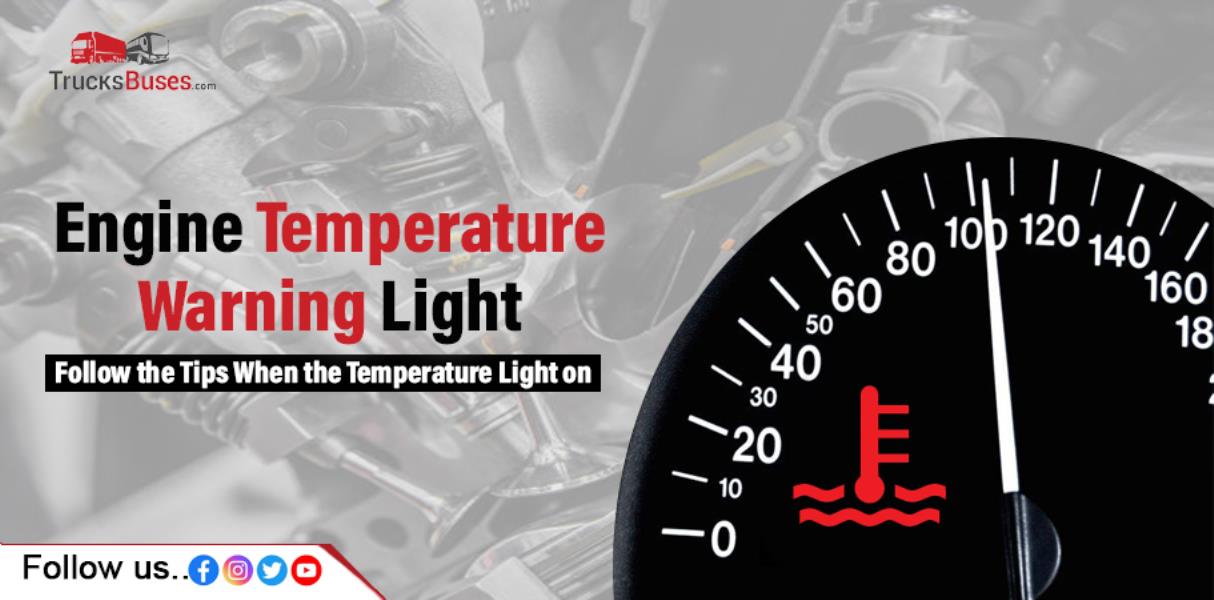Engine Temperature Warning Light - Follow the Tips When the Temperature Light on
When you are driving your truck, the appearance of the engine temperature warning light can be alarming. This light signals that your engine is getting too hot and needs immediate attention. Knowing what steps to take can prevent serious damage and keep your truck running smoothly. Let’s break down what you should do if you see the temperature light on your dashboard.

What Does It Mean When the Temperature Light/Gauge is On?
1. What is the Engine Temperature Warning Light?
The engine temperature warning light often called the overheating light, is usually represented by a thermometer icon or an engine symbol with wavy lines. This light indicates that your engine is running hotter than normal, which can lead to overheating if not addressed promptly.
2. Why is the Engine Temperature Light Important?
When the engine temperature light comes on, it means that your truck engine is too hot. This could be due to various reasons such as low coolant levels, a malfunctioning thermostat, or a failing water pump. Ignoring this warning can lead to severe engine damage, so it’s crucial to take the right steps.
What Must You Do When the Temperature Light on Your Dashboard Comes On?
What’s the First Step if the Temperature Warning Light Goes On?
Pull Over Safely: As soon as you notice the high coolant temperature warning light, find a safe spot to pull over. Avoid stopping suddenly, especially on busy roads. Use your hazard lights to alert other drivers.
Should You Turn Off the Engine Immediately?
Yes, Turn Off the Engine: After safely pulling over, turn off the engine. This helps prevent further damage by allowing the engine to cool down. Wait at least 30 minutes before opening the hood to check for any issues.
Can You Check the Coolant Level Yourself?
How Do You Check the Coolant Level?
Inspect Coolant Levels: Once the engine has cooled down, check the coolant reservoir. If the coolant level is low, add the recommended type of coolant. Ensure you follow the manufacturer's guidelines for the correct coolant type.
What If You Notice Coolant Leaks?
Look for Leaks: Check under the truck for any signs of coolant leaking. Coolant is usually bright green, pink, or orange and has a sweet smell. If you spot a leak, you may need to call for roadside assistance or get your truck towed to a repair shop.
Should You Drive If the Engine Temperature Light Remains On?
Is It Safe to Drive with the Temperature Light On?
No, Don’t Drive: If the temperature warning light stays on even after the engine has cooled down, driving the truck can cause further damage. Have your truck inspected by a mechanic to diagnose and fix the issue.
What Could Cause the Overheating Light to Stay On?
Possible Causes: The engine temperature warning light might remain on due to issues like a stuck thermostat, a failing water pump, or a damaged radiator. It’s important to get a professional diagnosis to determine the exact problem.
What Are Common Causes of Engine Overheating?
Why Does Low Coolant Cause Overheating?
Coolant Issues: Low coolant levels can lead to engine overheating because there isn’t enough fluid to absorb and transfer heat away from the engine. Regularly checking and maintaining the proper coolant level can help prevent this issue.
How Can a Faulty Thermostat Lead to Overheating?
Thermostat Problems: The thermostat regulates the flow of coolant through the engine. If it fails, it can get stuck in a closed position, preventing coolant from circulating and causing the engine to overheat.
What Happens if the Water Pump Fails?
Water Pump Failure: The water pump is responsible for circulating coolant through the engine and radiator. A malfunctioning water pump can lead to poor coolant circulation, resulting in engine overheating.
Can a Radiator Issue Cause the Temperature Light to Come On?
Radiator Problems: The radiator helps to cool the coolant before it returns to the engine. If the radiator is blocked or damaged, it can’t cool the coolant effectively, leading to overheating.
How Can You Prevent the Engine Temperature Warning Light from Coming On?
What Routine Checks Can Help Prevent Overheating?
Regular Maintenance: Follow the manufacturer’s recommended maintenance schedule for your truck. Regularly check coolant levels, inspect for leaks, and ensure that the thermostat and water pump are in good working order.
How Often Should You Check the Coolant Levels?
Routine Checks: Check your truck’s coolant level at regular intervals, especially before long trips. Keeping an eye on the coolant levels can help you catch potential issues before they cause overheating.
What Are Some Preventative Tips for Avoiding Overheating?
Preventative Measures: Ensure that the cooling system is well-maintained. Replace worn-out hoses, flush the radiator as recommended, and keep an eye on the temperature gauge during your drive.
Conclusion
The engine temperature warning light is a serious indicator that your truck's engine is running too hot. If the temperature light on your dashboard comes on, it’s crucial to act quickly. Pull over safely, turn off the engine, check coolant levels, and look for any leaks. If the light remains on, do not drive your truck and seek professional help.
Regular maintenance and prompt attention to warning lights can prevent overheating and ensure the longevity of your truck. By understanding what to do when the engine temperature warning light comes on, you can protect your vehicle and keep it running smoothly.
Read Also:
Understanding Gearbox Systems - Types & Uses
5 Best Trucks for Small Businesses in India: A Look at Mahindra’s Offerings